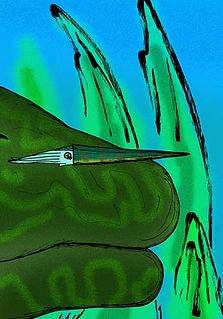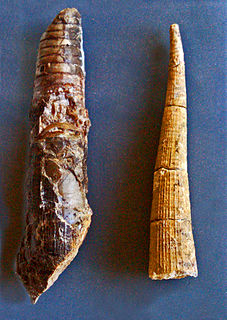
Nautiloids are a large and diverse group of marine cephalopods (Mollusca) belonging to the subclass Nautiloidea that began in the Late Cambrian and are represented today by the living Nautilus and Allonautilus. Nautiloids flourished during the early Paleozoic era, where they constituted the main predatory animals, and developed an extraordinary diversity of shell shapes and forms. Some 2,500 species of fossil nautiloids are known, but only a handful of species survive to the present day.

Orthoceratidae is an extinct family of actively mobile carnivorous cephalopods, subclass Nautiloidea, that lived in what would be North America, Europe, Asia, Africa, and Australia from the Ordovician through Triassic from 490—203.7 mya, existing for approximately 286.4 million years.

Orthocerida is an order of extinct Orthoceratoid cephalopods also known as the Michelinocerida that lived from the Early Ordovician possibly to the Late Triassic. A fossil found in the Caucasus suggests they may even have survived until the Early Cretaceous. They were most common however from the Ordovician to the Devonian.

The Bactritida are a small order of more or less straight-shelled (orthoconic) cephalopods that first appeared during the Emsian stage of the Devonian period with questionable origins in Pragian stage before 409 million years ago, and persisted until Carnian pluvial event in the upper middle Carnian stage of the Triassic period. They are considered ancestors of the ammonoids, as well as of the coleoids.

Lamellorthoceratidae is a family of fossil orthoceratoids in the Orthocerida, defined by Curt Teichert in 1961. The lamellorthoceratids are placed in the superfamily Orthocerataceae in the Treatise on Invertebrate Paleontology.
The Lituitida are the Lituitidae of the Treatise, reranked as an order and combined with other orthoceratoids. They are considered to be more closely related to the Orthocerida than to the Ascocerida or Pseudorthocerida which are also included.

Pseudorthocerida is an order of generally straight longiconic Orthoceratoids with a subcentral to marginal cyrtochoanitic siphuncle composed of variably expanded segments which may contain internal deposits that may develop into a continuous parietal lining.. Cameral deposits are common and concentrated ventrally. Apices typically have a slight to moderate exogastric curvature

Kionoceras is an extinct nautiloid cephalopod genus included in the orthocerid family Kionoceratidae with scattered worldwide distribution from the Middle Ordovician to the Lower Permian. Kionoceratids are orthocerids with prominent longitudinal ornamentation on their shells, sometimes augmented by secondary transverse ornamentation. Orthocerids are, of course, prehistoric nautiloides with generally straight and elongate shells, mostly with central or subcentral siphuncles.
Baltoceratidae is an extinct family of orthoconic cephalopods belonging to the subclass Nautiloidea endemic to what would be Asia, Australia, Europe, North America, and South America during the Ordovician living from about 480–460 mya, existing for approximately 20 million years.

Geisonoceratidae is an extinct family of orthoceroid cephalopods endemic to what would be Asia, Europe, and North America from the Middle Ordovician to the Middle Devonian living from about 470—380 mya, existing for approximately 90 million years. With the possible addition of an Early Cretaceous orthocerid from the western Caucasus the range of this group increases dramatically to some 350 million years, thus making it one of the longest lived families of the Nautiloidea.

Proteoceratidae is an extinct family of actively mobile aquatic carnivorous cephalopods belonging to the subclass Orthoceratoidea endemic to what would be Asia, Australia, Europe, South America and North America during the Ordovician living from 490—445.6 Ma, existing for approximately 44.4 million years.

Paraphragmitidae is an extinct family of actively mobile aquatic carnivorous cephalopods belonging to the subclass Orthoceratoidea endemic to what would be Asia and Europe during the Silurian living from 436—418.7 mya, existing for approximately 17.3 million years.
Cyptendoceras is an extinct nautiloid cephalopod included in the family Ellesmeroceratidae that lived in what would be North and South America during the latter part of the Early Ordovician from about 475 - 472 mya, existing for approximately 3 million years.
Rioceras is an extinct genus of orthocerid cephalopods of the family Baltoceratidae that lived in what would be North America during the Early Ordovician from 480—472 mya, existing for approximately 8 million years.
Paradnatoceras is an extinct straight-shelled cephalopod genus that lived in what would become China during the Ordovician from 478.6 to about 461 mya, existing for approximately 17.6 Ma.
Pseudorthocerataceae is an extinct superfamily of actively mobile carnivorous cephalopod, essentially a Nautiloid, that lived in what would be North America, Europe, Australia, and Asia during the Ordovician from 490—445.6 mya, existing for approximately 44.4 million years.

Orthoceratoidea is a subclass, formerly considered an infraclass or a superorder, that comprises Cephalopoda orders that have orthoconic to slightly cyrtoconic shells and central to subcentral siphuncles in which there may be internal deposits. Currently, Orthoceratoidea comprises the orders Dissidocerida, Ascocerida, Pseudorthocerida, Lituitida and Orthocerida.

Plagiostomoceras is an orthocerid cephalopod from the lower Paleozoic of Europe and Australia.
Temperoceras is a genus of orthoconic nautiloid cephalopods named by Barskov in 1960 that lived in what is now north Africa, Europe, and Asia during the early Paleozoic.
Murrayoceras is a nautilid cephalopod included in the orthocerid family Baltoceratidae, widespread in the Middle Ordovician of North America, characterized by a depressed orthoconic shell with a subtriangular cross section and flattened venter and a proportionally large ventral siphuncle, 0.15 to 0.3 the dorso-ventral shell diameter. Septa are close spaced with sutures forming broad lobes on the upper flanks and ventral surface.








